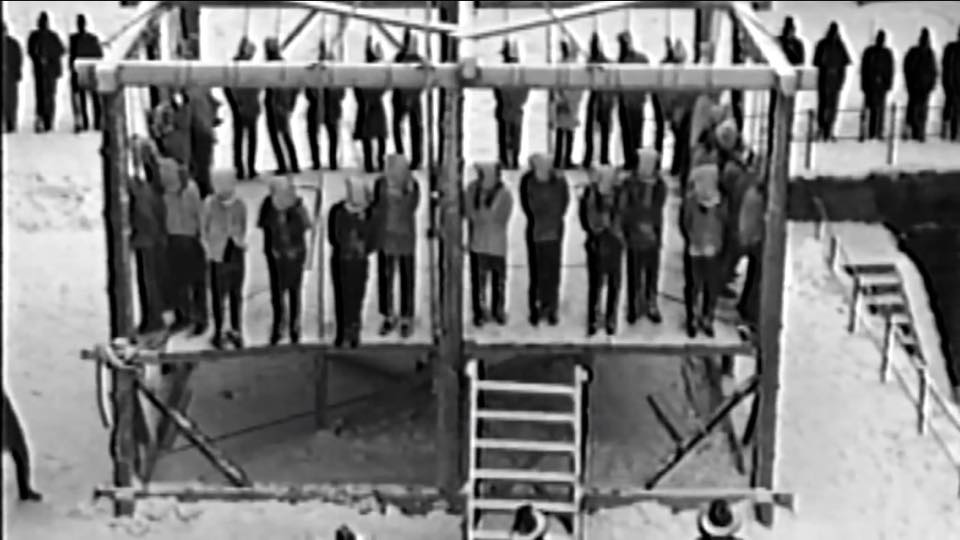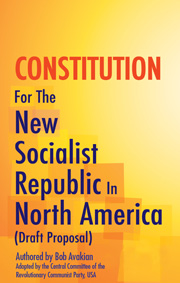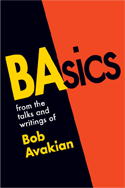Case #37: December 26, 1862: The Lynching of 38 Dakota Men―The Largest Mass Execution in U.S. History
| Revolution Newspaper | revcom.us
Bob Avakian has written that one of three things that has "to happen in order for there to be real and lasting change for the better: People have to fully confront the actual history of this country and its role in the world up to today, and the terrible consequences of this." (See "3 Things that have to happen in order for there to be real and lasting change for the better.")
In that light, and in that spirit, "American Crime" is a regular feature of revcom.us. Each installment will focus on one of the 100 worst crimes committed by the U.S. rulers—out of countless bloody crimes they have carried out against people around the world, from the founding of the U.S. to the present day.
THE CRIME
On December 26, 1862, in the midst of the U.S. Civil War (April 1861-May 1865), and in the same week that the Emancipation Proclamation was issued, President Abraham Lincoln ordered 38 Dakota Santee Sioux men sent to the gallows in Mankato, Minnesota. They were hooded and hanged simultaneously from a single scaffold, surrounded by 1,500 Union troops and a howling lynch mob of 4,000 white settlers. It was the largest mass execution in U.S. history.
The 38 had been taken prisoner after the Dakota people rose up against the U.S. government on August 17 in the Dakota Uprising of 1862. The Dakota people had been under relentless assault for 10 years—with deceitful and broken treaties, their reservations encroached on, their annuities unpaid, promised goods late or never delivered, price gouging and other abuses by the U.S. government and their agents. In 1858, the government took half the Dakota people’s reservation and opened it to white settlement. During the 1850s, over 160,000 settlers flooded the area, seizing and clearing the Native Dakota people’s lands to the point where their hunting and fishing virtually ended and starvation loomed.
On August 15, when half-starved Dakota people asked for food from a well-stocked warehouse, the government food trader Andrew Jackson Myrick replied: “[I]f they are hungry, let them eat grass or their own dung,” which was cited by Dakota Chief Little Crow as the last straw in provoking the Dakota to revolt. Myrick was one of the first killed and his body found with his mouth stuffed with grass. The uprising was sparked off when four starving Dakota youths, on an egg-stealing foray, impulsively killed five white settlers.
The 38 condemned men were told of their impending deaths on December 22 while shackled in pairs and bolted to the prison floor. They were among the 303 condemned to die in a mass trial of 392 Dakota men. Each defendant had five to 10 minutes in which to defend himself before a military court. On one day alone, 40 were tried, charged, and convicted for “murder and outrages.” A law professor later noted: “Most of them did not speak English. They did not even know they were being tried for crimes. Most also did not have counsel defending them.” Little evidence of their “crimes” existed. So the U.S. government used some defendants, who faced charges and execution themselves, to testify against other Dakotas in multiple trials. One such defendant-turned-witness provided evidence in 55 cases.
After the mass lynching, the bodies of the Dakotas were thrown into a mass grave. It was dug up that night, and the bodies were distributed to doctors for use as medical cadavers. Later, small boxes supposedly containing skin removed from the bodies were sold in Mankato.
There was never an official count of the settlers killed in this war. Accounts of the death toll in the 37 days of fighting vary widely, from 77 U.S. government troops, 29 citizen-soldiers or militia, and 300-800 settlers as well as some 29-150 Dakota warriors. After the uprising, more than 1,600 Dakota men, women, and children were exiled to a concentration camp on Pike Island, Minnesota, where living conditions were so bad that infections killed more than 300. In April 1863, the U.S. Congress abolished the Dakota reservation, declared all prior treaties with the Dakota null and void, and expelled the Dakota people completely from Minnesota. To this end, a $25 bounty was put on any Dakota found free within the boundaries of the state. U.S. General Oscar Malmros offered a bounty of $200 to independent scouts for each Dakota Sioux scalp.
Little Crow escaped capture until July 3, 1863, when he and his son left their hidden camping spot to pick raspberries. Two settlers shot and killed Little Crow. His body was dragged down the main street of Hutchinson and firecrackers were put in his nose and ears. His scalp, skull, and remains were put on display in St. Paul, Minnesota, until 1971. Two other Dakota leaders, Little Six and Medicine Bottle, had escaped to Canada but were captured, drugged, returned to the U.S., and hung in 1865.
THE CRIMINALS
President Abraham Lincoln (March 1861-April 1865). Lincoln oversaw the breaking of treaties and the robbing of the Dakotas and other Native peoples of their land, livelihood, and often their lives. And he sent troops to crush their resistance. Lincoln made clear his white supremacist views. Speaking in February 1860, he asked “[W]hy did Yankees almost instantly discover gold in California, which had been trodden upon and overlooked by Indians and Mexican greasers for centuries?” He also argued that phonetic writing was what separated whites from “savages,” and that this ability had given rise to the fruits of civilization—government, culture, etc. In 1863, Lincoln said: “Although we are now engaged in a great war between one another, we are not, as a race, so much disposed to fight and kill one another as our red brethren.”
U.S. troops and their commanders who were sent to put down the Dakota uprising. Companies led by Capt. Joseph F. Bean, Capt. David D. Lloyd, Capt. Calvin Potter, Capt. Mark Hendrick, and elements of the 5th and 6th Iowa Militia. Col. Henry Sibley played a pivotal role in the 1851 treaty negotiations that cheated the Dakota of their land, and then led U.S. troops to suppress their 1862 uprising. Sibley also oversaw the military tribunal that convicted the 38 as well as the punitive expeditions against the Dakota of 1863. Gen. John Pope was sent by Lincoln to command the 3rd, 4th, 9th, and 10th Minnesota Volunteer Infantry Regiments and openly stated: “It is my purpose to utterly exterminate the Sioux. They are to be treated as maniacs and wild beasts.”
Minnesota Governor Alexander Ramsey exiled the entire Dakota Santee people, offered bounty for their scalps, and said: “The Sioux Indian must be exterminated or driven forever beyond the borders of the State. The public safety imperatively requires it. Justice calls for it. The blood of the murdered cries to heaven for vengeance.”
Thomas Galbraith, Andrew Myrick, and other traders who withheld cash payments, food, and other trade goods owed to the Dakota people causing their increasing hunger, hardship, and anger.
The New York Times sensationalized stories of how settlers died and wrote racist depictions of the Dakota prisoners, fueling mass hysteria and bloodlust: “It was a sad, a sickening sight, to see that group of miserable dirty savages, chained to the floor, and awaiting with apparent unconcern for the terrible fate....”
THE ALIBI
The Dakota men were executed for the killing of innocent white settlers, and Lincoln was being lenient by hanging only 38 of the 303 who were tried and condemned to death by the military court.
THE ACTUAL MOTIVE
The Dakota Uprising was a just uprising and one of many by various Native tribes throughout the U.S. against the genocide being committed against them by the U.S. government and white settlers. During the 1860s, many Native peoples like the Dakotas were compelled to rise up by years of exploitation and oppression, including imminent starvation.
Lincoln explained to the U.S. Senate: “Anxious to not act with so much clemency as to encourage another outbreak on one hand, nor with so much severity as to be real cruelty on the other, I ordered a careful examination of the records of the trials to be made, in view of first ordering the execution of such as had been proved guilty of violating females.” Given only two men were found guilty of rape, he expanded the criteria to include those who had taken part in “massacres” of civilians rather than just “battles.” In contrast, Lincoln did not indict or execute any Confederate soldiers for such crimes.
It also may have been important to make an example of the Dakota people and their uprising because, despite having few fighting forces, little equipment like canons, and being outmatched in guns and ammunition, they fought very effectively against the U.S. military. For example, U.S. forces suffered a major defeat at the Battle of Birch Coulee on September 2, 1862, where a three-hour firefight ended with 13 U.S. soldiers dead and 47 wounded, while only two Dakota warriors were killed.
During this period, the Union, representing the interests of the capitalist class centered in the North, was waging the Civil War. At the same time, railroads were being built across the country and settlements vastly expanded. The robbery of the huge land mass from coast to coast occupied by the many Native tribes, the defeat of any resistance to this historic colonial expansion, and the outright genocide carried out against Native peoples were foundational to the growth and development of U.S. capitalism and the later rise of the U.S. empire.
Sources
BAsics from the Talks and Writings of Bob Avakian, 1:2, RCP Publications, 2011
Bury My Heat at Wounded Knee, An Indian History of the American West by Dee Brown, Chapter 3, “Little Crow’s War,” Holt, Rinehart & Winston, 1970
Dakota War of 1862, Wikipedia
“Sham Trials: The Traumatic Truth of What Happened to the Dakota 38,” by Konnie LeMay, Indian Country Today, December 26, 2015
The Dakota Conflict, documentary aired January 27, 1993, produced by KTCA, St. Paul, Minneapolis, Minnesota

Lynching of 38 Dakota (Santee Sioux) men, December 26, 1862.
Excerpt on Native Americans, from the Constitution for the New Socialist Republic in North America (Draft Proposal)
C. Native Americans.
1. The conquest, domination, plunder and life-stealing exploitation carried out by European colonialism in the Americas–including by the European settlers who founded the United States of America and expanded its reach on the North American continent through force and violence, as well as deception and other means–had a massive genocidal impact, decimating and devastating the populations of the first inhabitants of the Americas. As the boundaries of the USA were continuously expanded through conquest–and huge numbers of Native Americans were killed or died off due to this armed expansionism and the destruction of their way of life, the spread of diseases common among Europeans for which the Native Americans had no immunity, and other factors–most of the Native Americans who survived were forced onto reservations that were encircled and controlled by the forces of the imperialist state.
2. The defeat of this imperialist state has opened the way to overcoming the effects and legacy of this terrible history. As one key expression of the importance it attaches to this, the New Socialist Republic in North America shall ensure that the right of autonomy of Native American peoples within this Republic is upheld; and, beyond that, wherever autonomous regions of Native Americans may be established, in the general vicinity of the historical homelands of the various native peoples, the central government will also act to ensure that these autonomous regions not only have the necessary territories but also the resources that will enable a real flourishing of these peoples, within the overall framework of the New Socialist Republic in North America. The central government of the New Socialist Republic in North America will provide special assistance and support to any Native American autonomous regions, on the basis of the principles and objectives set forth in this Constitution.
3. This special assistance and support shall be especially important with regard to Native American autonomous regions, but also with regard to concentrations of Native Americans in urban areas and other parts of this Republic–where autonomous Native American areas may also be set up–and with regard to the Native American population as a whole.
Such special assistance and support will also be of great importance, and shall be extended, to all the formerly oppressed peoples, and any autonomous regions and areas of these peoples, within the New Socialist Republic in North America.
Check out the Constitution for the New Socialist Republic in North America (Draft Proposal) and order it online.
If you can conceive of a world without America—without everything America stands for and everything it does in the world—then you’ve already taken great strides and begun to get at least a glimpse of a whole new world. If you can envision a world without any imperialism, exploitation, oppression—and the whole philosophy that rationalizes it—a world without division into classes or even different nations, and all the narrow-minded, selfish, outmoded ideas that uphold this; if you can envision all this, then you have the basis for proletarian internationalism. And once you have raised your sights to all this, how could you not feel compelled to take an active part in the world historic struggle to realize it; why would you want to lower your sights to anything less?
Bob Avakian, BAsics 1:31
Get a free email subscription to revcom.us:

Volunteers Needed... for revcom.us and Revolution
If you like this article, subscribe, donate to and sustain Revolution newspaper.



